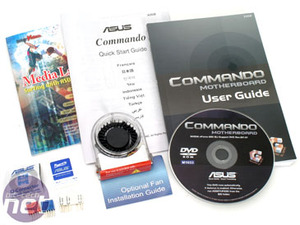Asus Commando
Price (as reviewed): £143.35 (inc VAT)Latest UK Pricing
Latest US Pricing
While gaming motherboards become a new breed of quality and expense, Asus continues to fill the market with its now esteemed Republic of Gamers line-up. The latest addition to the RoG range is based on the popular P965 chipset for Intel LGA775 processors. Enter the Commando...
The Commando has the now usual rear LCD, on-board illuminated buttons and heatpipe cooling arrangement, as well as eight phase power and "Extreme Tweaker" underneath. P965 boards are usually less expensive than most high end boards because the chipset doesn't cost as much as some others. So while Asus usually charges more for its RoG boards, this should be a more affordable choice than the £200+ Striker Extreme.
Originally, Intel's P965 chipset wasn't designed with multi-GPU, and thus CrossFire, in mind. Instead, limited CrossFire support was tacked on at a later date. With only x4 bandwidth coming out of the second PCI-Express x16 slot, we had to find out if this really does make the Commando as elite as its status suggests, or whether it's merely lacking in the underwear department.
Asus Commando Overview
- Support for all Intel LGA775 processors, including Pentium 4, Pentium D, Pentium Extreme Edition, Core 2 Duo, Core 2 Quad and Core 2 Extreme;
- Intel P965 and ICH8R chipset;
- Support for up to 8GB of DDR2-533, DDR2-667 or DDR2-800MHz memory;
- Two PCI-Express x16 slots for CrossFire (providing a fixed x16 and x4 bandwidth);
- Four PCI slots;
- ADI1988B SupremeFX High-Definition Audio codec with 8 channel audio, jack sensing, and S/PDIF, Asus noise filter and DTS connect;
- Marvell Gigabit Ethernet PCI and PCI-Express LAN adapters;
- Six native SATA 3Gbps ports supporting RAID 0, 1, 0+1, 5 and JBOD with Intel Matrix Storage;
- JMicron JMB363 controller for one IDE port;
- Support for ten USB 2.0 ports (four on rear I/O panel, six via on-board pins / expansion brackets);
- Two IEEE1394a Firewire ports (one on rear I/O panel, one via on-board pins / expansion brackets).


Bundle
- Six red SATA cables;
- Three molex to six SATA power adapters;
- One black IDE ribbon cable;
- One black floppy ribbon cable;
- PCI bracket with two USB 2.0 ports;
- PCI bracket with one 6-pin IEEE1394a Firewire port;
- Optional radial heatpipe cooling fan;
- Asus Q-connector;
- Motherboard manuals and driver CD.


There are separate PCI brackets for USB and Firewire ports, of which could both have been included on a single one. Considering there are six USB ports supported on the motherboard, it surely can't cost that much more to include another two on the same bracket to support four. Two USB 2.0 ports are traditionally routed to the front of the case anyway, so at least four should be included.
While the motherboard also features pin outs for thermal probes, they have been dropped from the bundle. Although it was only an extra that doesn't impede on the functionality of the board at all, it's a unique extra that you can't easily just pick up in any online store. Asus might as well have dropped the entire functionality altogether.
The bundle isn't perfect, but it doesn't just throw in the kitchen sink: Asus merely gives you the essentials for the most widely used features on the board. For a while, the Republic of Gamer brand had connotations to the DFI LANParty series with the extras included, but it's increasingly moving from this position as price competitiveness is seen as more important.

MSI MPG Velox 100R Chassis Review
October 14 2021 | 15:04









Want to comment? Please log in.